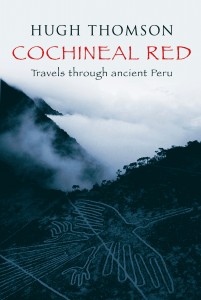.
Peru wears its ancient cultures wrapped around in layers, like one of the mummified
bodies so well preserved by the nitrates of its deserts. After The White Rock, his book
on the Incas, Hugh Thomson unwraps those earlier layers of Peruvian civilisations to show
how they flourished so spectacularly in this toughest and most arid of terrains.
.

Reviews of
Cochineal Red: Travels through Ancient Peru
(published as A Sacred Landscape in USA)
.
‘A dizzying tour through five turbulent millennia. The cumulative effect is enthralling.’ Sara Wheeler, The Times
‘What makes Cochineal Red such a worthwhile book is that it is written by someone who is both an explorer and a scholar.’ Toby Green, The Independent
‘Epic – in an increasingly homogeneous world, he has found, and describes to perfection, a mythical land.’ Publishing News
‘Conveys not only Thomson’s great knowledge of the ancient civilisations of the Andes, but also the thrill of the chase for such knowledge.’ Matthew Parris, The Spectator
‘A fascinating, intelligently told tale, full of intriguing revelations, that penetrates deeper into the Andean past than previously attempted.’ Traveller Magazine
‘Communicates all the excitement of participating in the discovery of a hidden world.’ J.H.Elliott, author of Empires of the Atlantic World.
‘Reminds us that the world is not, after all, explored.‘ Benedict Allen, Independent on Sunday, Books of the Year
Many of the extraordinary cultures of Ancient Peru, from the lines of Nasca to the temple-cult
of Chavín, buried in the mountains, and the great pyramids of the coast, have only started to give up
their secrets and antiquity in just the last few years.
As one archaeologist put it: ‘Imagine if all the discoveries of Ancient Egypt had been made so recently
– the finding of Tutankhamen’s tomb, of the Great Pyramid of Cheops, of Abu Simbel – and you have some
idea of the great excitement at what has been happening in Peru.’
Hugh has been at the forefront of some of these discoveries himself, having made headlines with his work
near Machu Picchu. Now he takes the reader on a journey back from the world of the Incas to the first dawn
of Andean civilisation, to give an immensely personal and accessible guide to the wonders that have been revealed.
Published by Weidenfeld & Nicolson
.
From the Introduction:
‘This book is an exercise in compressed time: into the year described I have poured many of my feelings about Peru over the past twenty-five years, and I have likewise used it to explore five millennia of Ancient Peruvian history as I travelled through the country.
The impetus for this came from my continuing investigations at the Inca site of Llactapata, near Machu Picchu, as it became increasingly difficult to understand the Inca mindset without a fuller understanding of the thousands of years of Andean culture that preceded the Inca.
The story therefore begins with Llactapata and the Incas before returning to the dawn of Peruvian civilisation at Caral in around 3000 BC and moving through the millennia to return to the present day.
In a book spanning 5000 years of Andean history, there is an inevitable concentration on the ‘summits in the range’, to the exclusion of some of the smaller civilisations: I was drawn to explore the principal and defining cultures which left enduring monuments, from the great pyramids of the coast, with their tombs and murals, to the temple-cult of Chavín, buried in the mountains, and the lines of Nasca.
There is a virtue to this broad brush approach, in that it can help to see Ancient Peru as a continuum rather than many individual and discrete cultures. Andean culture developed in lurches and in different places across Peru, but a book such as this can give a panorama showing how consistent the development of their way of viewing the world seems to have been, and how different it was from ours.’


Pingback: Getting Real High In the Peruvian Andes | ramblin' boy